Explore Sharjah - United Arab Emirates (UAE) Travel, Asia
Sharjah, one of the seven emirates in the United Arab Emirates (UAE), offers a captivating blend of history, culture, and modernity. Known as the "Cultural Capital of the Arab World," Sharjah draws tourists with its rich heritage, stunning architecture, and vibrant arts scene. Unlike its neighboring cities, Sharjah maintains a deep connection to its roots while providing a wealth of experiences for travelers seeking authentic Arabian culture. Whether you’re a history buff, art enthusiast, or nature lover, Sharjah promises an unforgettable journey.
Population: Approximately 1.8 million in 2023.
Economy: Sharjah's economy is diverse, with key sectors including manufacturing, real estate, trade, and tourism. It is a business-friendly hub, supporting SMEs and fostering growth in culture and industry.
Landmarks: Famous for the Al Noor Mosque, Sharjah Museum of Islamic Civilization, the Sharjah Desert Park and Mleiha Archaeological Centre.Sharjah, one of the seven emirates in the United Arab Emirates (UAE), offers a captivating blend of history, culture, and modernity. Known as the "Cultural Capital of the Arab World," Sharjah draws tourists with its rich heritage, stunning architecture, and vibrant arts scene. Unlike its neighboring cities, Sharjah maintains a deep connection to its roots while providing a wealth of experiences for travelers seeking authentic Arabian culture. Whether you’re a history buff, art enthusiast, or nature lover, Sharjah promises an unforgettable journey.
Population: Approximately 1.8 million in 2023.
Economy: Sharjah's economy is diverse, with key sectors including manufacturing, real estate, trade, and tourism. It is a business-friendly hub, supporting SMEs and fostering growth in culture and industry.
Landmarks: Famous for the Al Noor Mosque, Sharjah Museum of Islamic Civilization, the Sharjah Desert Park and Mleiha Archaeological Centre.
United Arab Emirates
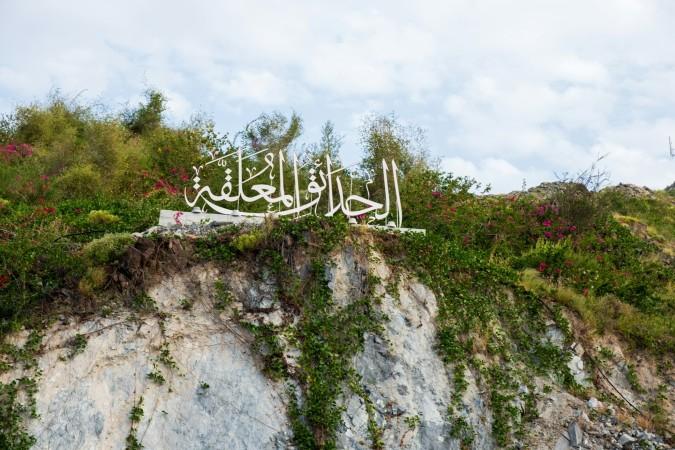
Overview of Sharjah
History & Cultural Influence
Sharjah’s history stretches back over 6,000 years, making it one of the oldest continuously inhabited regions in the Arabian Peninsula. As an important trading port during ancient times, it played a significant role in commerce between the East and the West. In 1998, UNESCO recognized Sharjah as the Cultural Capital of the Arab World, cementing its position as the epicenter of the UAE’s arts and heritage. The influence of both ancient Bedouin traditions and Islamic culture is evident in Sharjah’s architecture, festivals, and daily life. Its commitment to cultural preservation makes it stand out as a must-visit destination for travelers who want to understand the region's roots.
Interaction with the Locals
Sharjah, the third-largest emirate in the UAE, has a population of approximately 1.8 million people, with a diverse mix of expatriates and locals. Emirati citizens make up a smaller portion of the population, with the majority being expatriates from South Asia, the Middle East, and other regions. The local Emirati community is known for its strong cultural traditions, warm hospitality, and deep-rooted Islamic values, which are reflected in daily life and social customs throughout the emirate.
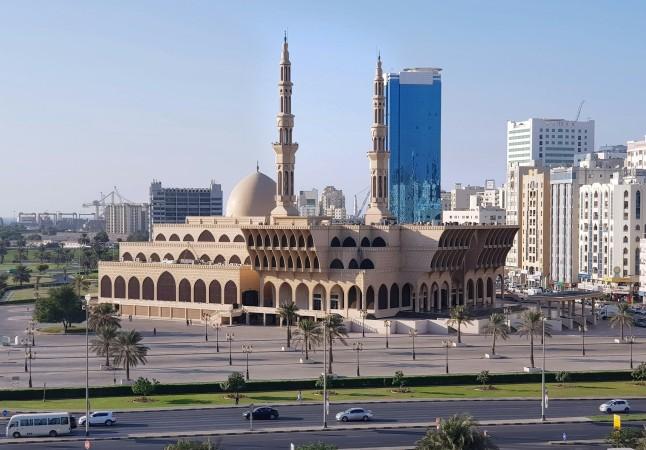
Al Noor Mosque, Sharjah - © Palani selvam
Top Attractions in Sharjah
Sharjah is home to a rich tapestry of cultural, historical, and natural wonders. The emirate offers a wide array of attractions that suit all types of travelers, from those passionate about art and history to families seeking fun and educational activities.
Al Noor Mosque
Situated along the Khalid Lagoon, Al Noor Mosque is one of Sharjah’s most famous landmarks, admired for its majestic domes and intricate minarets. Its Ottoman-inspired design draws architectural enthusiasts and photographers alike. While most mosques in Sharjah are not open to non-Muslims, Al Noor Mosque is an exception. Guided tours allow visitors to gain insight into Islamic culture, architecture, and religious practices, making it an educational experience for international tourists. Don't forget to dress modestly and respectfully, as it is an active place of worship.
Sharjah Museum of Islamic Civilization
Located near Corniche Street, this museum is housed in a grand building with a traditional Arab-Islamic design. Inside, you’ll find over 5,000 Islamic artifacts ranging from ancient manuscripts and textiles to scientific instruments and ceramics. One of the museum's standout features is its detailed exhibits on the Golden Age of Islamic civilization, showcasing how early Muslim scholars contributed to fields such as astronomy, medicine, and navigation.
Sharjah Desert Park and Mleiha Archaeological Centre
Located on the outskirts of the city, the Sharjah Desert Park offers a unique opportunity to explore the region's natural and historical heritage. The park includes a Natural History Museum, which introduces visitors to the flora and fauna of the Arabian Peninsula. Meanwhile, the Mleiha Archaeological Centre delves into Sharjah’s prehistoric past, showcasing fossils, ancient burial sites, and artifacts from early human settlements. Visitors can also participate in desert safaris, hiking, and stargazing tours for a more immersive experience.
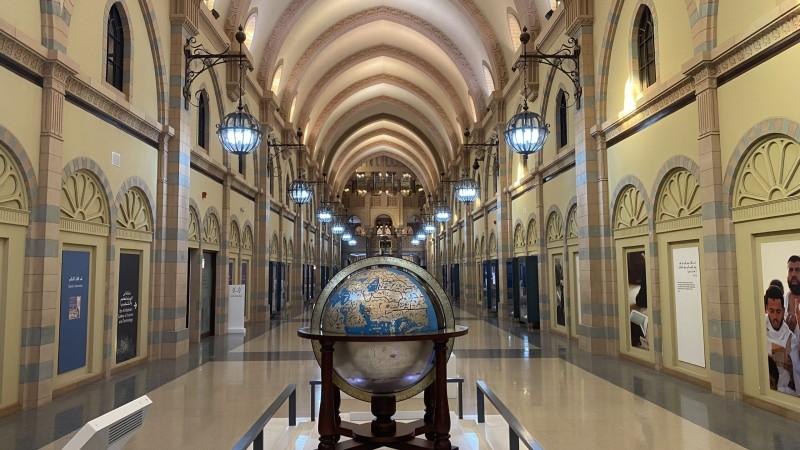
Sharjah Museum of Islamic Civilization - © Sandsplus L.L.C-FZE
Must-Try Dishes in Sharjah
Sharjah’s culinary tradition is a vibrant reflection of its rich cultural heritage, offering a diverse range of traditional Emirati dishes that combine bold flavors and time-honored cooking methods.
- Al Machboos: Al Machboos is one of the most popular traditional dishes in Sharjah. It consists of spiced rice cooked with tender lamb, chicken, or fish, and flavored with saffron, cardamom, and dried lemon (loomi). Slow-cooked for hours, the result is a flavorful and aromatic dish with a perfect balance of spices.
- Harees: Harees is a dish that dates back centuries and is commonly prepared during the holy month of Ramadan and Eid celebrations. Made by simmering wheat and meat (usually lamb or chicken) until the wheat breaks down into a porridge-like consistency, this hearty dish is simple yet filling.
- Luqaimat: Luqaimat, often served as a dessert or snack, are crispy on the outside and soft on the inside. These fried dough balls are typically drizzled with date syrup or honey and sprinkled with sesame seeds.
- Shawarma: Shawarma is a beloved street food not only in Sharjah but across the Middle East. It consists of thinly sliced meat (usually chicken or lamb) that’s roasted on a vertical spit, then wrapped in pita bread with garlic sauce, pickles, and salad.
- Balaleet: Balaleet is an Emirati breakfast dish that blends the sweet and savory in an unexpected way. It consists of sweetened vermicelli noodles cooked with sugar, cardamom, saffron, and rose water, served with a savory omelet on top.
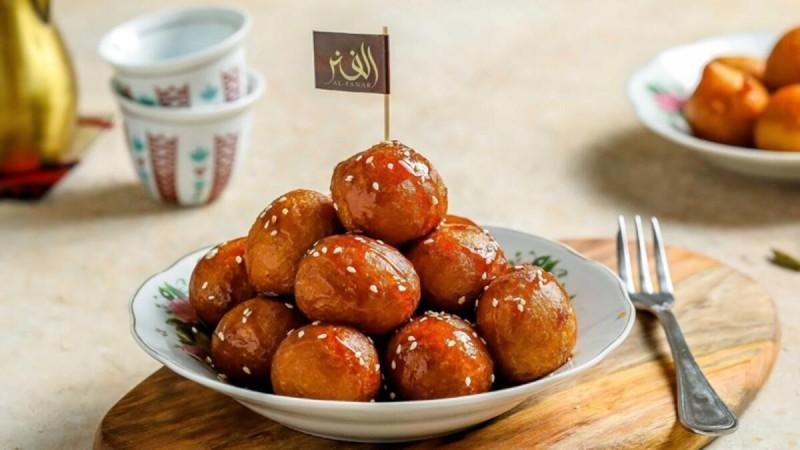
Luqaimat - © Khaleej Times
Festivals & Local Celebrations
Sharjah Light Festival
Every February, Sharjah’s iconic buildings and landmarks are transformed into stunning canvases of light during the Sharjah Light Festival. This 10-day event showcases incredible light projections, turning historic sites like mosques, forts, and museums into dynamic works of art. The festival celebrates the fusion of art, technology, and history, drawing in tourists and locals alike to witness the breathtaking displays.
Eid Celebrations
Eid al-Fitr and Eid al-Adha are two of the most significant religious celebrations in the Islamic calendar. During Eid, Sharjah comes alive with special prayers, family gatherings, and festive meals. Visitors can experience the emirate’s vibrant cultural atmosphere through public events, including concerts, fireworks, and traditional performances.
Ramadan in Sharjah
During the holy month of Ramadan, Sharjah takes on a different rhythm. Fasting from dawn to sunset is observed, and the emirate offers a range of cultural and spiritual activities. At night, after breaking the fast with iftar meals, the streets come alive with Ramadan markets, cultural performances, and religious lectures. Visitors are encouraged to respect the customs of Ramadan and join in the communal celebrations.
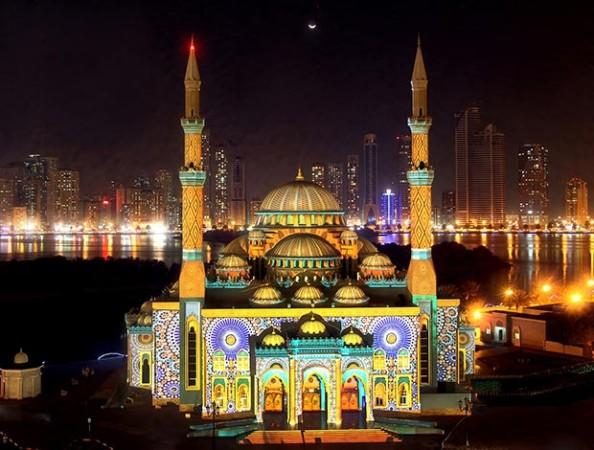
Sharjah Light Festival - © Islamic Arts Magazine
What to Do in Sharjah
- Desert Safaris and Dune Bashing: One of the most thrilling activities Sharjah offers is a desert safari. Visitors can explore the vast sand dunes on a 4x4 adventure, known as dune bashing, or enjoy a more leisurely camel ride across the golden landscapes.
- Stroll Along Al Majaz Waterfront: The Al Majaz Waterfront is a popular spot for families and couples looking to unwind. It features beautiful walking paths, green spaces, and views of the Khalid Lagoon. You can rent a bike, take a boat ride, or simply enjoy a meal at one of the many restaurants while watching the Sharjah Fountain Show.
- Explore Al Noor Island: Al Noor Island is a unique destination that combines nature, art, and architecture. Stroll through the lush Butterfly House, admire the contemporary sculptures, or relax in the peaceful gardens. It’s a great place to recharge and connect with nature in the midst of Sharjah’s urban landscape.
Shopping in Sharjah
- Souq Al Arsah: Souq Al Arsah is a traditional market that offers a glimpse into Sharjah’s past. Wander through its narrow alleys and discover shops selling everything from antiques and handicrafts to perfumes and jewelry.
- Central Souq (Blue Souk): One of Sharjah’s most famous shopping destinations, the Central Souq, also known as the Blue Souk, is a two-story building adorned with stunning Islamic architecture. Inside, you’ll find a wide array of traditional goods, including carpets, textiles, and gold jewelry.
- Sahara Centre: If you’re looking for a more contemporary shopping experience, Sahara Centre offers a wide range of international brands, from fashion to electronics. The mall also features a variety of dining options, a cinema, and entertainment facilities for families, making it a one-stop destination for both shopping and leisure.
- City Centre Sharjah: City Centre Sharjah is another modern shopping complex, popular for its accessibility and range of global retail outlets. From fashion and electronics to groceries and lifestyle products, it caters to both locals and tourists.
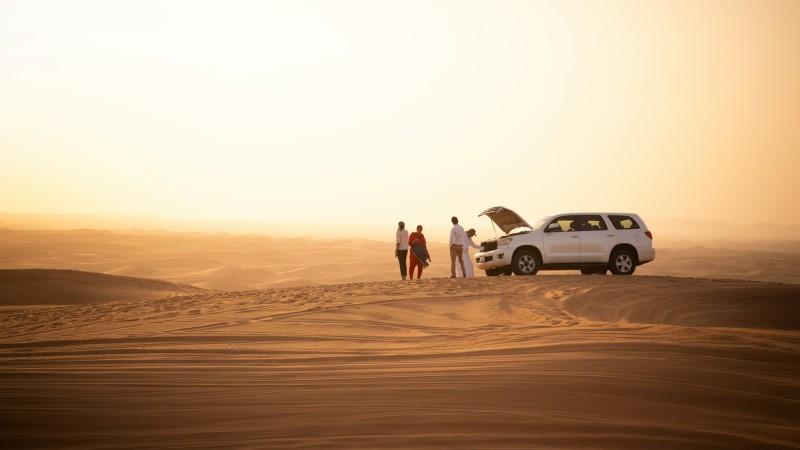
Desert Safaris around Sharjah - © Danish Puri
Weather in Sharjah: Best Time to Visit
Summer in Sharjah
During the summer months, temperatures in Sharjah can soar well above 40°C (104°F), with humidity levels often making it feel even hotter. Outdoor activities, like desert safaris and sightseeing, can be challenging during this time. However, this is a good time to enjoy indoor attractions like museums, malls, and cultural centers, as they’re all air-conditioned.
Winter in Sharjah
Winter is the best time to visit Sharjah, as the weather is mild and ideal for outdoor activities. Daytime temperatures range between 18°C to 28°C (64°F to 82°F), making it perfect for exploring the city’s landmarks, beaches, and desert parks. This season also hosts major festivals like the Sharjah Light Festival.
Spring and Autumn in Sharjah
Spring and autumn serve as transitional periods between the intense summer heat and the mild winter. The weather during these times is generally warm but manageable, with temperature around 25°C to 35°C (77°F to 95°F)making it a good time for tourists who prefer fewer crowds. It’s a great season for cultural events and festivals that occur before the peak tourist season.
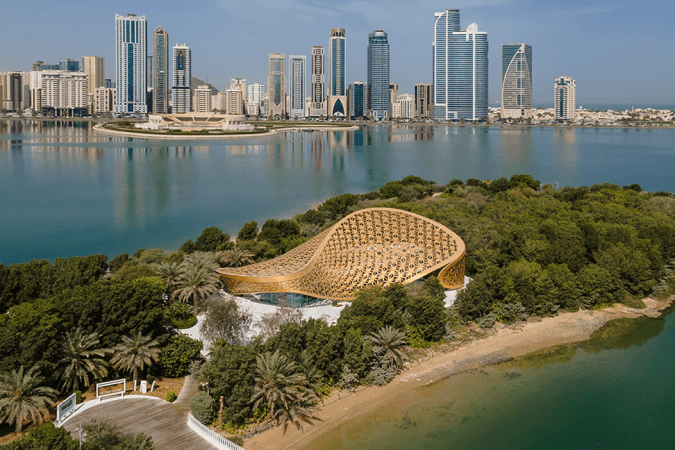
Explore Al Noor Island to hide from the heat of the desert - © Al Noor Island Official website
Essential Travel Information
Getting Around Sharjah
- Public Buses: Sharjah’s bus network is extensive, connecting the city’s major attractions, shopping areas, and neighborhoods. Tourists can purchase Sayer Cards, a rechargeable smart card used to pay for fares.
- Taxis: Taxis are widely available across Sharjah and are a convenient option for tourists. They’re metered, affordable, and safe, with most drivers speaking basic English. Taxis are especially useful for traveling to locations not easily accessible by bus or for short trips within the city.
- Car Rentals: Renting a car is a great option if you plan to explore Sharjah at your own pace or venture into other emirates like Dubai or Abu Dhabi. Several international and local car rental companies operate in Sharjah, with daily and weekly rental options.
ATM & Banking Services
Sharjah offers convenient access to banking services and ATMs throughout the city, making it easy for tourists to manage their finances during their stay. ATMs are widely available in shopping malls, airports, hotels, and tourist areas, and most machines accept major international debit and credit cards. While ATMs typically provide a favorable exchange rate, currency exchange services can also be found in popular locations, offering competitive rates for foreign currency.
Where to Stay in Sharjah
- Luxury Hotels: Sharjah boasts several high-end hotels and resorts, offering premium amenities, stunning views, and top-notch service. These luxury options are often located near the beach or key cultural attractions, combining traditional Emirati hospitality with modern conveniences.
- Mid-Range Hotels: These hotels typically offer modern amenities such as free Wi-Fi, restaurants, fitness centers, and easy access to major landmarks. Ideal for families, business travelers, and tourists alike, these accommodations offer excellent service at reasonable rates.
- Budget Accommodation: Budget-conscious visitors will find plenty of affordable accommodation options, from basic hotels to guesthouses and hostels. These options provide clean and comfortable rooms with essential amenities, making them perfect for backpackers or travelers looking to explore Sharjah on a smaller budget.
Des articles pour vous

Voyage à Kampong Cham - Cambodge, Asie
Kampong Cham est une charmante ville riveraine située le long du fleuve Mékong. Connue pour son importance historique et ses attractions culturelles, Kampong Cham offre un mélange d'architecture coloniale, de temples anciens et de paysages pittoresques. Kampong Cham est reliée au district voisin de Tbong Khmum par le pont Kizuna, le premier pont au Cambodge à traverser le fleuve Mékong, en faisant un carrefour de transport crucial pour la région.
Population : Estimation de 80 000 habitants (en 2024)
Économie : Bien que n'étant pas encore une destination touristique majeure, Kampong Cham propose des sites culturels et historiques, tels que le temple Wat Nokor et le pont en bambou de Koh Pen, ainsi que des attractions naturelles comme des forêts et des chutes d'eau. Le gouvernement se concentre sur le développement du tourisme pour améliorer l'économie locale.
Points d'intérêt : Wat Nokor Bachey, Phnom Han Chey, Phnom Pros et Phnom Srey, pont en bambou de Koh Pen, Wat Joy T'maw, Preah Theat Teuk Chha, piste d'atterrissage abandonnée de l'US.

Explorez Nha Trang - Voyage au centre du Vietnam, Asie
Nichée le long de la magnifique côte du Vietnam, Nha Trang se distingue comme une destination de premier choix pour les voyageurs. Cette ville côtière, réputée pour ses superbes plages et sa vie marine foisonnante, s'adresse à tous. Nha Trang vous accueille à bras ouverts, que vous recherchiez des aventures, de la culture ou de la détente au bord de la mer. Ce guide vous fera découvrir les points forts de cet endroit magnifique, facilitant ainsi la planification de votre voyage de manière fluide et excitante.
Population : Environ 423 000 habitants en 2019.
Économie : L'un des principaux centres touristiques du Vietnam et la plus grande économie de la province de Khanh Hoa.
Sites emblématiques : Célèbre pour les tours Cham de Po Nagar, la cathédrale de Nha Trang et l'île Hon Mun.

Voyage à Sihanoukville - Cambodge, Asie
Sihanoukville, une ville côtière du sud-ouest du Cambodge, est la capitale de la province de Preah Sihanouk. Située sur une péninsule le long du golfe de Thaïlande, la ville est bien reliée à Phnom Penh par des autoroutes principales et dispose d'un aéroport international.
La ville abrite le seul port en eau profonde du Cambodge, jouant un rôle crucial dans la logistique et le commerce du pays. Les plages magnifiques de Sihanoukville, telles qu'Ochheuteal et Serendipity, attirent aussi bien les touristes nationaux qu'internationaux. Le développement économique a prospéré ces dernières années, en particulier grâce à la création de la Zone économique spéciale de Sihanoukville (SSEZ) et aux investissements chinois dans les casinos, l'immobilier et les stations balnéaires. La ville offre également des attractions naturelles telles que le parc national de Ream et plusieurs îles voisines, en faisant une destination variée pour les voyageurs d'affaires et de loisirs.
Population : La population de Sihanoukville était d'environ 160 000 habitants en 2024.
Économie : Sihanoukville, une ville côtière en pleine croissance au Cambodge, se distingue par son mélange dynamique de développement économique et de tourisme. La Zone économique spéciale de Sihanoukville (SSEZ) est devenue un pôle industriel majeur, abritant plus de 180 entreprises et créant des milliers d'emplois. Avec le seul port en eau profonde du Cambodge, la ville joue un rôle clé dans le commerce et la logistique du pays. Bien qu'elle se soit transformée d'une petite ville balnéaire tranquille en un centre urbain animé, Sihanoukville reste célèbre pour ses plages immaculées, attirant des touristes tout au long de l'année. Les investissements chinois importants ont alimenté la croissance des hôtels, des casinos et de l'immobilier, faisant de la ville un centre d'opportunités économiques et d'hospitalité.
Monuments : Plage d'Otres, Plage d'Ochheuteal, Plage de l'Indépendance, Parc national de Ream, Chute d'eau de Kbal Chhay, Monument des Lions d'Or, Wat Leu.

Explorez Kharkhorin - Voyage en Mongolie, Asie
Bienvenue à Kharkhorin, un trésor historique niché au cœur de la Mongolie. Ancienne capitale vibrante de l'Empire Mongol sous le légendaire Gengis Khan, Kharkhorin se dresse comme un témoignage de la riche culture et de l'histoire de la Mongolie. Cette ville antique possède une combinaison unique d'importance historique et de paysages époustouflants, en faisant une destination incontournable pour un voyage de rêve en Mongolie. En mettant le pied à Kharkhorin, vous ferez un saut dans le temps, à une époque de grands palais, de routes commerciales prospères et d'échanges culturels sans pareils. Que vous soyez intrigué par les ruines anciennes, désireux d'explorer les traditions locales ou simplement en quête d'une immersion dans la beauté naturelle de la Mongolie, Kharkhorin a quelque chose à offrir à chacun.
Population : Environ 1 000 habitants en 2020.
Économie : L'une des attractions touristiques les plus importantes de la Mongolie et l'ancienne capitale de l'Empire Mongol.
Monuments : Célèbre pour les Ruines de Kharkhorin, le Monastère d'Erdene Zuu, et la Vallée d'Orkhon, un site du patrimoine mondial de l'UNESCO.

Explore Luang Prabang - Laos Travel, Asia
Luang Prabang, nestled in northern Laos at the meeting point of the Mekong river and Nam Khan river, is a city celebrated for its rich cultural heritage and stunning natural beauty. Recognized as a UNESCO World Heritage Site in 1995, it boasts a unique blend of traditional Lao and French architecture that has been carefully preserved. Whether you're wandering through its ancient temples, admiring the local architecture, or soaking in the natural beauty of waterfalls and rivers, Luang Prabang offers something for everyone.
Population: Approximately 470,000 in 2020.
Economy: Luang Prabang's economy thrives on tourism, with its UNESCO status drawing visitors to its temples, natural wonders, and cultural experiences. Local crafts, hospitality, and small businesses also play vital roles, supporting the town's sustainable growth. Local crafts, hospitality, and small businesses also play vital roles, supporting the town's sustainable growth.
Landmarks: Famous for the Wat Xieng Thong, Royal Palace Museum (also known as Haw Kham), and Mount Phousi (Phou Si Hill).Luang Prabang, nestled in northern Laos at the meeting point of the Mekong river and Nam Khan river, is a city celebrated for its rich cultural heritage and stunning natural beauty. Recognized as a UNESCO World Heritage Site in 1995, it boasts a unique blend of traditional Lao and French architecture that has been carefully preserved. Whether you're wandering through its ancient temples, admiring the local architecture, or soaking in the natural beauty of waterfalls and rivers, Luang Prabang offers something for everyone.
Population: Approximately 470,000 in 2020.
Economy: Luang Prabang's economy thrives on tourism, with its UNESCO status drawing visitors to its temples, natural wonders, and cultural experiences. Local crafts, hospitality, and small businesses also play vital roles, supporting the town's sustainable growth. Local crafts, hospitality, and small businesses also play vital roles, supporting the town's sustainable growth.
Landmarks: Famous for the Wat Xieng Thong, Royal Palace Museum (also known as Haw Kham), and Mount Phousi (Phou Si Hill).

Explore Vientiane - Laos Travel, Asia
Vientiane, the capital of Laos, offers a unique travel experience for those looking to explore a peaceful Southeast Asian city with a deep connection to its cultural roots. Unlike other bustling capitals, Vientiane boasts a serene and laid-back atmosphere, making it a perfect destination for travelers wanting to escape the chaos of more crowded cities. This charming city sits along the Mekong River, offering scenic views, rich history, and a vibrant yet tranquil way of life. As a gateway to exploring Laos, this capital invites you to slow down, immerse in its heritage, and enjoy the local flavors.
Population: Approximately 840,000 in 2023.
Economy: Vientiane's economy is growing steadily, driven by government services, trade, and tourism. Key sectors include agriculture, manufacturing, and construction. The city's strategic location along the Mekong River supports trade with neighboring Thailand and Vietnam.
Landmarks: Famous for the Pha That Luang, Patuxai, and the Buddha Park (or Wat Xieng Khuan).
